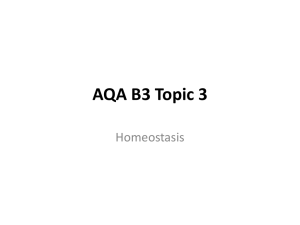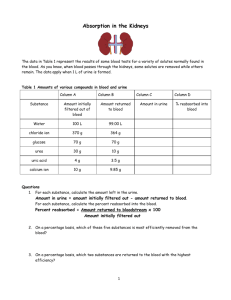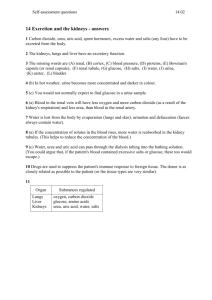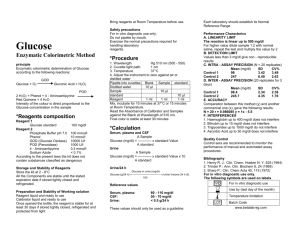More Homeostasis questions
advertisement
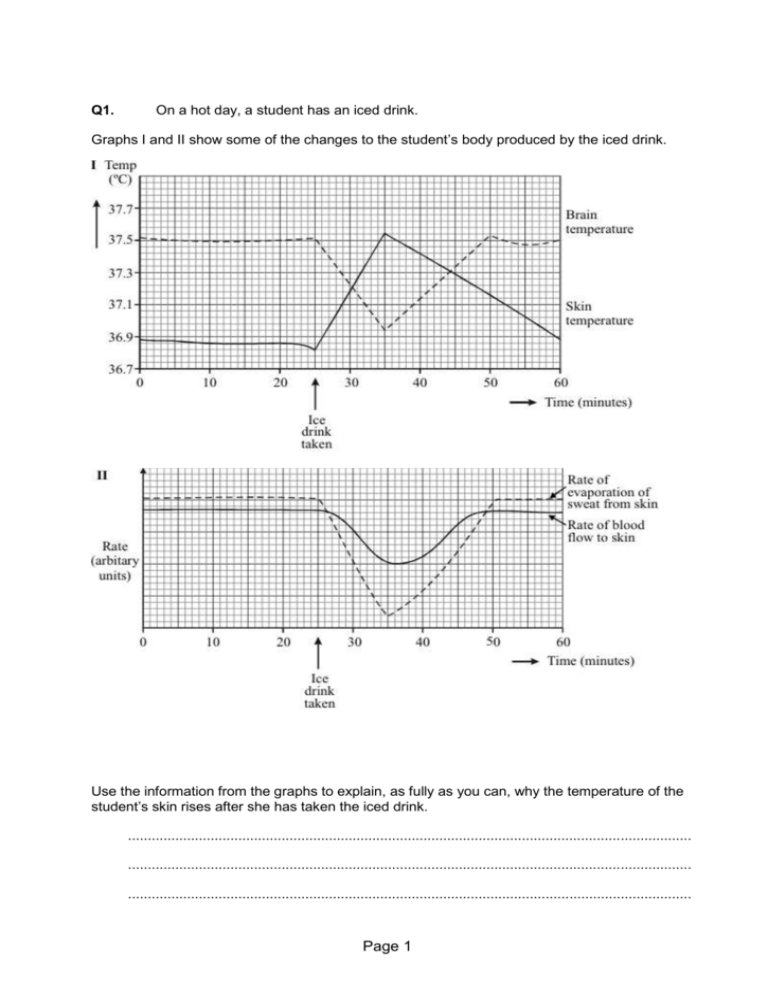
Q1. On a hot day, a student has an iced drink. Graphs I and II show some of the changes to the student’s body produced by the iced drink. Use the information from the graphs to explain, as fully as you can, why the temperature of the student’s skin rises after she has taken the iced drink. ............................................................................................................................................... ............................................................................................................................................... ............................................................................................................................................... Page 1 ............................................................................................................................................... ............................................................................................................................................... ............................................................................................................................................... (Total 4 marks) Q2. The diagram shows how the blood sugar level is controlled in the body. Explain fully what would happen if somebody ate some glucose tablets. ............................................................................................................................................... ............................................................................................................................................... ............................................................................................................................................... ............................................................................................................................................... ............................................................................................................................................... ............................................................................................................................................... (Total 4 marks) Page 2 Q3. The graph shows the concentration of glucose in the blood of two people. Person A is a non-diabetic. Person B has diabetes. Each person ate 75 grams of glucose at 1.0 hours. (a) (i) What was the maximum concentration of glucose in the blood of Person A? .................................................................. mmol per dm3 (1) (ii) After eating the glucose, how long did it take for the concentration of glucose in the blood of Person B to return to normal? Page 3 ................................................................................ hours (1) (b) A diabetic person does not produce enough insulin. (i) Which organ produces insulin? ........................................................................................................................... (1) (ii) Write the letter X on the graph to show one time when the blood of Person A would contain large amounts of insulin. (1) (c) A high concentration of glucose in the blood can harm body cells as a result of osmosis. Explain why. ............................................................................................................................. ........ ............................................................................................................................. ........ ............................................................................................................................. ........ ............................................................................................................................. ........ ............................................................................................................................. ........ ............................................................................................................................. ........ ............................................................................................................................. ........ (4) (Total 8 marks) ## The table shows the concentrations of some substances in human blood plasma, in the filtrate produced by the kidney and in the urine. Page 4 Concentration in grams per dm3 Substance Blood plasma Filtrate Urine Glucose 1.0 1.0 0.0 Amino acids 0.5 0.5 0.0 Urea 0.3 0.3 20.0 Protein 80.0 0.0 0.0 Ions 7.2 7.2 15.0 Water 912.0 990.0 970.0 (a) Explain why: (i) the concentration of glucose in the filtrate is the same as in the blood plasma; ........................................................................................................................... ........................................................................................................................... (1) (ii) there is no glucose present in the urine. ........................................................................................................................... ........................................................................................................................... (1) (b) Suggest why there is no protein present in either the filtrate or the urine. ............................................................................................................................. ...... ............................................................................................................................. ...... (1) (c) The volume of water removed in the urine is variable. Explain how the human body reduces the volume of urine produced when less water is consumed. ............................................................................................................................. ...... Page 5 ............................................................................................................................. ...... ............................................................................................................................. ...... ............................................................................................................................. ...... ............................................................................................................................. ...... ............................................................................................................................. ...... (3) (Total 6 marks) Q5. The food we eat affects how quickly the blood glucose concentration changes. In an experiment a person ate two slices of white bread. Her blood glucose concentration was recorded over the next 120 minutes. The experiment was repeated: • first with two slices of brown bread • then with two slices of wholemeal bread. The graph shows the results of the three experiments. Page 6 (a) Describe the effect of eating two slices of white bread on the person’s blood sugar concentration. ........................................................................................................................ ........................................................................................................................ ........................................................................................................................ ........................................................................................................................ (2) (b) Wholemeal bread would be most suitable for a person with diabetes. Explain why. ........................................................................................................................ ........................................................................................................................ ........................................................................................................................ ........................................................................................................................ ........................................................................................................................ ........................................................................................................................ ........................................................................................................................ (3) (Total 5 marks) Page 7 Q6. The hormone insulin is a protein. Insulin is produced in the pancreas and controls blood glucose concentration. (a) Which organ in the body monitors blood glucose concentration? .................................................................................................................................... (1) (b) We now know that a lack of the hormone insulin causes diabetes. In the early twentieth century there was no known cure for diabetes. Frederick Banting and Charles Best carried out a number of experiments on dogs. In the first experiment they removed part of the pancreas from a healthy dog (dog A). They ground up the pancreas tissue and injected an extract into dog B, whose pancreas had been removed to make it diabetic. Dog B’s diabetes was not cured. Banting thought that an enzyme produced in the pancreas of dog A had digested the hormone before it was injected. Name the enzyme that might have been responsible for digesting the hormone. .................................................................................................................................... (1) (c) In the second experiment with another healthy dog, Banting and Best tied off the duct which normally carries digestive enzymes out of the pancreas. This did not kill the dog. (i) The dog survived even though enzymes from the pancreas could not digest food in the intestine. Explain why the dog survived. Page 8 .......................................................................................................................... .......................................................................................................................... .......................................................................................................................... (1) (ii) As a result of these experiments, a method was developed to extract insulin from the pancreas. Insulin is used to treat humans with diabetes. The amount of insulin injected needs to be carefully controlled. Explain why. .......................................................................................................................... .......................................................................................................................... .......................................................................................................................... (1) (d) Evaluate the use of dogs in experiments of this type. Remember to include a conclusion to your evaluation. .................................................................................................................................... .................................................................................................................................... .................................................................................................................................... .................................................................................................................................... .................................................................................................................................... .................................................................................................................................... .................................................................................................................................... (3) (Total 7 marks) Q7. Diabetes is caused when the body does not produce enough insulin. Page 9 (a) The bar graph shows the number of people with diabetes per 1000 of population. (i) How many more males aged between 45 and 64 years of age have diabetes than males under 45 years of age? Show clearly how you work out your answer. ........................................................................................................................... ........................................................................................................................... Answer ................................. per 1000 of population (2) (ii) Describe the way in which the number of females with diabetes changes with age. ........................................................................................................................... ........................................................................................................................... ........................................................................................................................... ........................................................................................................................... ........................................................................................................................... (2) (b) One way of treating diabetes is by injecting insulin. Page 10 Insulin is a protein. (i) If insulin is taken by mouth, it is broken down in the digestive system. Where in the digestive system would insulin be broken down? Draw a ring around your answer. liver mouth stomach (1) (ii) Give one way of treating diabetes instead of using insulin. ........................................................................................................................... ........................................................................................................................... (1) (Total 6 marks) Q8. Urine consists of water, ions and other substances such as urea. Urine is formed in the kidney by filtering the blood. The diameter of the pores in the filter is about 6 nanometres. The table shows the diameters of the molecules of some of the substances in the blood. Substance Diameter of molecule in nanometres A 10 to 20 B 1.0 C 0.6 D 0.5 E 0.2 Use information from the table and your own knowledge to answer the questions. (a) (i) Which substance, A, B, C, D or E, is protein? Page 11 (1) (ii) Explain why protein is not found in the urine of a healthy person. ........................................................................................................................... ........................................................................................................................... ........................................................................................................................... ........................................................................................................................... (2) (b) Substance B is not found in the urine of a healthy person. Suggest an explanation for this. ..................................................................................................................................... ..................................................................................................................................... ..................................................................................................................................... ..................................................................................................................................... (2) (c) Haemolytic anaemia is a disease in which some of the red blood cells burst open. Small amounts of haemoglobin may be found in the urine of a person suffering from haemolytic anaemia. The diameter of a haemoglobin molecule is 5.5 nanometres. Haemoglobin is not found in the urine of a healthy person, but can be found in the urine of a person with haemolytic anaemia. Explain why. ..................................................................................................................................... ..................................................................................................................................... ..................................................................................................................................... ..................................................................................................................................... ..................................................................................................................................... ..................................................................................................................................... ..................................................................................................................................... Page 12 ..................................................................................................................................... (3) (Total 8 marks) Q9. (a) (i) Urine is made in the kidneys and stored for a few hours before being released from the body. In which organ of the body is urine stored? Draw a circle around one answer. bladder large intestine liver (1) (ii) Which two of the following substances are not found in the urine of a healthy person? Tick ( ) two boxes. glucose mineral ions protein urea (2) (b) A person with kidney disease may be treated by dialysis or by having a kidney transplant. Read the information about dialysis and kidney transplants. • A person needs 3 dialysis sessions a week, each lasting about 8 hours. • Intake of protein and salt in the food is kept low between dialysis sessions. • For each patient, dialysis costs £30 000 per year. Page 13 • The use of a general anaesthetic can sometimes cause brain damage. • Drugs to suppress the immune system are given after a kidney transplant. • A transplant costs £20 000 in the first year plus £6500 in each of the following years for drugs. Use this information to answer the questions. (i) Give two advantages of treatment by having a kidney transplant rather than treatment by dialysis. 1 ....................................................................................................................... .......................................................................................................................... 2 ....................................................................................................................... .......................................................................................................................... (2) (ii) Give one disadvantage of treatment by having a kidney transplant. .......................................................................................................................... .......................................................................................................................... (1) (c) The table shows the amounts of some substances in the blood of one patient before dialysis and after dialysis. Substance Concentration in blood plasma in grams per dm3 Before dialysis After dialysis Sodium ions 2.88 3.00 Potassium ions 0.22 0.14 Urea 4.50 0.30 During dialysis, substances are removed from the blood. Page 14 (i) Which substance in the table decreased in concentration the most during dialysis? ........................................................................................................................... (1) (ii) By how much did the concentration of this substance decrease? ................................................... grams per dm3 (1) (Total 8 marks) Q10. Water can be lost from the body in several ways. The table shows the volume of water lost by a man on a cold day. Way in which water is lost In urine Volume of water lost in cm3 2000 Through skin 600 Breathed out 300 In faeces 100 Total 3000 (a) Calculate the proportion of water that the man lost through his skin. Show clearly how you work out your answer. ..................................................................................................................................... ..................................................................................................................................... Proportion = .............................................................. (2) Page 15 (b) More water is lost through the skin on a hot day than on a cold day. (i) Explain why. ........................................................................................................................... ........................................................................................................................... (1) (ii) To maintain water balance in the body, the total volume of water taken in must equal the total volume of water lost. Give two ways this is achieved on a hot day, when compared to a cold day. Tick ( ) two boxes. The volume of water in the urine decreases. The volume of water in the faeces increases. The volume of water taken as food or drink increases. The volume of water breathed out decreases. (2) (c) Use words from the box to complete the sentences. bladder kidney liver stomach The body cannot store amino acids. The body converts the amino acids it cannot use into urea. (i) Urea is made in the ............................................................................................ (1) (ii) Urea is removed from the blood by the ............................................................. (1) (iii) Urine is stored in the ......................................................................................... (1) (Total 8 marks) Page 16 Q11. The job of our kidneys is to remove unwanted substances from our blood. Substances which are needed in the blood must not be lost. The flow-diagram below shows how the kidneys do this job. (a) Describe what happens to the glucose and amino acids in the kidney. ..................................................................................................................................... ..................................................................................................................................... ..................................................................................................................................... ..................................................................................................................................... (4) (b) A man has 5 litres of blood in his body. In one day: • the kidneys filter out 170 litres of liquid from the blood. • he produces 1.5 litres of urine. Page 17 (i) What % of the filtered liquid is reabsorbed? ........................................................................................................................... ........................................................................................................................... (2) (ii) The man became ill because his kidneys would not absorb as much of the filtered liquid. Write down two ways the man would be affected by this. ........................................................................................................................... ........................................................................................................................... (2) (c) In an experiment the man drank 800cm³ of water. The diagram shows the effect this had on the volume of urine the man produced each 30 minutes. Describe, in as much detail as you can, how drinking the water affected the volume of urine produced afterwards. ..................................................................................................................................... ..................................................................................................................................... ..................................................................................................................................... ..................................................................................................................................... Page 18 ..................................................................................................................................... ..................................................................................................................................... ..................................................................................................................................... (5) (Total 13 marks) Q12. (a) The kidney controls the amount of water in the body. The table shows the volume of water filtered from the blood and the volume of urine produced in one day. Volume in dm3 Water filtered from blood Urine 180 2 Calculate the volume of water reabsorbed into the blood. Show clearly how you work out your answer. ..................................................................................................................................... Volume of water reabsorbed = ..............................dm3 (2) (b) On a hot sunny afternoon, Man A sat in the shade, drinking beer. Man B went jogging in the desert. Page 19 As a result, the volume and concentration of the urine of the two men were different. Complete the table by writing the word ‘higher’ or ‘lower’ in each box. The first line has been completed for you. Volume of urine produced Man A Man B higher lower Volume of water reabsorbed by the kidneys Concentration of urine (2) (Total 4 marks) Q13. Diabetes is a disease in which a person’s blood glucose concentration rises to higher levels than normal. Diabetes is caused by insufficient insulin being produced. (a) (i) Which organ monitors blood glucose concentration? ........................................................................................................................... (1) (ii) Insulin reduces the concentration of glucose in the blood. Describe how insulin does this. ........................................................................................................................... ........................................................................................................................... (1) (b) A person with diabetes can be monitored in three ways: • • measuring the blood glucose concentration after fasting (going without food for 12 hours) measuring the amount of glucose attached to red blood cells: this is a measure of the average blood glucose concentration over the previous three Page 20 • months measuring the concentration of insulin in the blood after fasting The manufacturer of a new treatment for diabetes, called Diacure, publishes the following two claims. 1. 98.6% of all people who used Diacure reported an improvement in their condition. 2. An independent study of 30 diabetic patients showed a significant reduction in blood glucose concentrations and a significant increase in insulin production, as shown by the graph. (i) Which of the manufacturer’s claims is not based on scientific evidence? ........................................................................................................................... ........................................................................................................................... (1) (ii) Why might the data in this study be unreliable? ........................................................................................................................... ........................................................................................................................... ........................................................................................................................... (1) (iii) The manufacturer did not draw attention to the data for the amount of glucose attached to red blood cells. Page 21 Suggest an explanation for this. ........................................................................................................................... ........................................................................................................................... ........................................................................................................................... ........................................................................................................................... ........................................................................................................................... (2) (iv) The study of diabetic patients was carried out by an independent company. Why is it important that the study should be independent? ........................................................................................................................... ........................................................................................................................... ........................................................................................................................... (1) (Total 7 marks) Q14. The table compares the percentages of various substances in a person’s blood and their urine. Substance Blood Urine Water 92.00% 95.00% Glucose 0.10% 0 Salt 0.37% 0.60% Urea 0.03% 2.10% (a) How does the level of urea in urine compare with the level of urea in the blood? ..................................................................................................................................... (2) Page 22 (b) The kidney produces urine by filtering the liquid part of blood and then re-absorbing some of the filtered substances. Use this information to explain the difference in the level of urea in urine compared to the level of urea in blood. ..................................................................................................................................... ..................................................................................................................................... ..................................................................................................................................... ..................................................................................................................................... (2) (Total 4 marks) Q15. Kidneys are important as they remove waste from blood and balance our water needs. Kidney failure can be treated by transplant or dialysis using a kidney “machine”. The money for expensive treatment for a few people could be used to provide more patients with less expensive treatment for other complaints. Dialysis – kidney “machines” Kidney transplant Most expensive Very expensive but cheaper than dialysis Need own machine or share machine in hospital Need kidney from relative or from “newly” dead person Restricted life – special diet, must return to machine Independent Can be used while patient waits for transplant Transplant may be rejected Discuss the advantages and disadvantages of using dialysis or kidney transplants to Page 23 keep people alive. ............................................................................................................................................... ............................................................................................................................................... ............................................................................................................................................... ............................................................................................................................................... ............................................................................................................................................... ............................................................................................................................................... ............................................................................................................................................... (Total 5 marks) Q16. To stay healthy, the amount of sodium in your body must not change very much. On average, a girl takes in 10 grams of sodium a day in the food she eats. The diagram shows what happens to this sodium. (a) Add the missing figure to the diagram. (1) (b) The girl goes on holiday to a very hot place. Her diet stays the same but she now loses 12g of sodium each day in sweat. Page 24 (i) How will this affect the amount of sodium she loses each day in her urine? ........................................................................................................................... (1) (ii) What should the girl do to make sure that her body still contains enough sodium? ........................................................................................................................... (1) (c) Usually, there is no glucose in urine. All of the glucose is re-absorbed from your kidney tubules back into your blood. Complete the following sentences to describe how this happens. The glucose is re-absorbed by a process called ......................................................... This process is needed because some of the glucose is re-absorbed against ..................................................................................................................................... (2) (Total 5 marks) Page 25 M1. ideas that internal cooling/cooling of brain causes reduction in sweating and of blood flow to skin less sweating = less loss of heat from skin (= X) less blood flow = less heat supplied to skin (= Y) X > Y (so temperature rises) each for 1 mark [4] M2. idea: glucose level rises pancreas releases insulin glucose → glycogen (in liver)/removes xs glucose glucose level falls/returns to normal for 1 mark each [4] M3. (a) (i) 6 1 (ii) 4 1 (b) (i) pancreas ignore islets of langerhans 1 (ii) ‘X’ anywhere between >1 and ≤ 2 hours anywhere in that column 1 Page 26 (c) any four from: water movement do not accept solution out of cells dilute to concentrated solution accept reference to correct gradient high to low or high to low ‘water concentration’ must be unambiguous – i.e. not ‘high to low concentration’ accept low to high concentration reference to partially / selectively permeable membranes or described cells shrink / get smaller allow crenated ignore plasmolysed / flaccid / floppy etc 4 [8] M4. (a) (i) glucose passes through the filter / from plasma to filtrate ignore diffuses 1 (ii) glucose is reabsorbed or glucose taken back into the blood ignore filtered 1 (b) protein (molecules) are (too) large (to pass through the filter) 1 (c) any three from: Page 27 blood becomes more concentrated / too salty / has lower water potential or too little water in the blood hypothalamus detects this release of ADH by pituitary increased reabsorption of water 3 [6] M5. (a) concentration rose to 7.9 1 then fell to normal at 120 minutes allow rose then fell for 1 mark 1 (b) there is a lower maximum / peak in the blood sugar concentration with wholemeal bread 1 there is also a slower rise in blood sugar concentration with wholemeal bread 1 because of the above the person needs to take less insulin or is less likely to hyper 1 [5] M6. (a) pancreas 1 (b) protease allow proteinase Page 28 1 (c) (i) (same) enzymes / named enzymes produced in other parts / named parts of digestive system if named, enzymes and part must be correct 1 (ii) diet / activity varies / amount of glucose in blood varies accept too much insulin leads to coma / hypo / low blood sugar accept too little insulin leads to coma / hyper / high blood sugar 1 (d) any two from: pros • less / no experimentation on humans • dogs (more) similar to humans (than lower / named organisms) • it allows us to find a treatment or improves medical understanding accept allows us to find a cure cons • harmful / cruel to dogs accept kills dogs • dogs may not be (metabolically) like humans 2 conclusion justified by argument 1 [7] M7. (a) (i) 50 award 2 marks for correct answer irrespective of working award 1 mark for selection of 60 and 10 2 Page 29 (ii) any two from: • increases • (then) decreases • highest at 65 – 74 (years old) or maximum 112 (per thousand) allow peaks at 65 - 74 ignore comparisons with men 2 (b) (i) stomach 1 (ii) any sensible reference to diet or carbohydrate intake or pancreas / stem cell transplant eg eat less / no sugary food or eat more fibre or go on a diet or watch what you eat ignore eat more protein do not accept reduce salt 1 [6] M8. (a) (i) A 1 (ii) (protein) molecule is large ignore letters 1 cannot pass through filter (protein is) too big to get through the filter = 2 marks 1 (b) B is taken back into the blood or B is reabsorbed 1 reabsorbed completely or reabsorbed after filtration 1 Page 30 (c) RBC is too big to pass through filter 1 Haemoglobin is inside red blood cells or haemoglobin released when red blood cell bursts 1 Haemoglobin is small enough to pass through filter or haemoglobin diameter < pore diameter 1 [8] M9. (a) (i) bladder 1 (ii) glucose 1 protein extras – CANCEL 1 (b) (i) any two from: • kidney functions all the time / not just 3 × 8 h sessions a week allow direct quotation of correct points from the list • can eat high-protein foods / high salt foods allow can eat anything • cheaper • waste of time 2 (ii) have to take (immunosuppressant) drugs / consequence of this eg catch infections / may suffer brain damage / possible rejection of kidney or become ill more easily or risk of brain damage (due to anaesthetic) allow direct quotation of correct points from the list 1 Page 31 (c) (i) urea 1 (ii) 4.2 1 [8] M10. (a) / 20% / 1 in 5 / 1 : 4 / 0.2 / any correct proportion ignore working do not allow 1 : 5 / 600 : 2400 / 600 in 3000 award 1 mark for selection of 3000 and 600 2 (b) (i) sweat / sweating / perspiring allow cooling / for cooling / to lose heat / to cool 1 (ii) the volume of water in the urine decreases. 1 the volume of water taken as food or drink increases. 1 (c) (i) liver apply list principle 1 (ii) kidney apply list principle 1 Page 32 (iii) bladder apply list principle 1 [8] M11. (a) idea: filtered for 1 mark reabsorbed gains 1 mark but all reabsorbed gains 2 marks correct reference to blood for 1 mark 4 (b) (i) evidence of gains 1 mark but 99(.1)(%) gains 2 marks 2 (ii) idea: more urine for 1 mark body dries out/dehydrates or needs to drink more for 1 mark 2 Page 33 (c) no effect for first half hour/until 1 hour rises to 210cm3/to 3x level after 1 hour rises to 280cm3/to 4x level after 1½ hour reference to 280cm3/1½ hour as maximum level falls to (near) normal after 2½ hours comparison of rates of change e.g. rapid then slower rise and/or steady fall not all of 800cm3 excreted (extra to normal) each for 1 mark to max. of 5 (do not credit simply rises then falls) 5 [13] M12. (a) 178 ignore working or lack of working correct working: 180 – 2 but no answer / wrong answer = 1 mark 2 (b) Man A Man B higher lower lower higher lower higher all 4 cells correct = 2 marks 2 or 3 cells correct = 1 mark 0 or 1 cells correct = 0 mark 2 [4] M13. (a) (i) pancreas allow phonetic spelling Page 34 1 (ii) glucose into cells / liver / muscles allow any named organ / cell allow turned into / stored as glycogen but do not allow hybrid spellings for glycogen allow increases respiration allow stored as / turned into fat 1 (b) (i) reference to “98.6% of all people who used Diacure reported an improvement in their condition”. allow claim 1 / 1 / the first one 1 (ii) (only) 30 patients or not enough / not many patients allow only one trial or only done once or not repeated ignore bias 1 (iii) little effect / difference allow no effect allow only drops by 4 (±1) 1 suggest drug is not effective (in long term) allow wouldn’t persuade people to take it 1 (iv) avoid bias / owtte eg company could change / ignore results / might lie ignore fair / accurate / reliable / valid 1 [7] ## (a) increases gains 1 mark but 70 × more (concentrated) Page 35 gains 2 marks 2 (b) idea that water is reabsorbed; urea is not reabsorbed (as much) each for 1 mark (credit (much) more water reabsorbed than urea) gains 2 marks 2 [4] M15. • cost of dialysis and transplant compared • idea that both expensive and may need to balance cost against other medical priorities restricted diet/movement with dialysis • and • no restriction/independence for transplant each for 1 mark • idea that donated kidney may not be available • transplant may be rejected/dialysis consistently reliable [Credit problem of finding body access points for repeated dialysis over the long term] [5] M16. (a) 1 for 1 mark 1 (b) (i) there will be less / no sodium (per day) (in her urine) for 1 mark 1 (ii) idea that Page 36 she should take in more (sodium (chloride) / salt) (allow stay indoors / in shade or be less active) for 1 mark 1 (c) active transport / uptake (do not allow diffusion / osmosis) the concentration / gradient for 1 mark each 2 [5] Page 37


